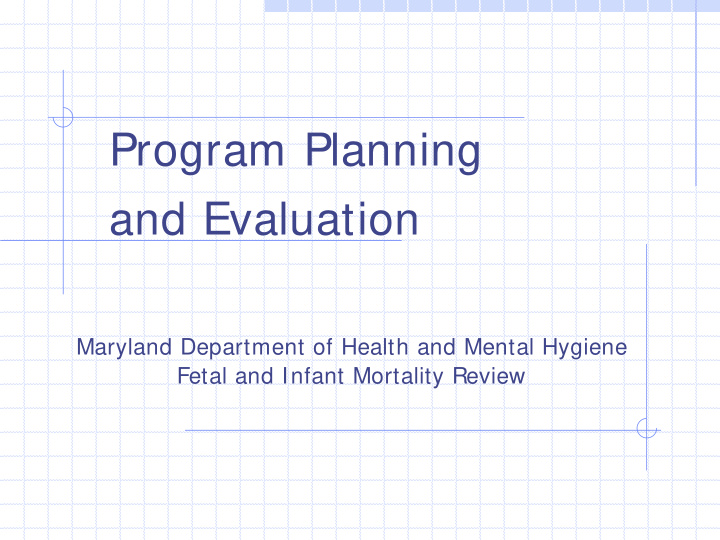



Program Planning and Evaluation Maryland Department of Health and Mental Hygiene Fetal and Infant Mortality Review
Definition of a Program Defined by CDC as any organized public health activity.
Effective Public Health Approach Readiness to Act—commitment of FIMR program. Needs assessment—FIMR data. Strategies—FIMR case review and community action teams. Planning Implementation Monitoring Evaluation Investment
Why Have an Action Plan? Provides a “map” to transform recommendations into action. Serves as general guidelines and structure for change Is a built-in monitoring and evaluation tool.
Elements of a Good Action Plan A statement of need identified by assessment data. A measurable performance target tied to the need. The steps or activities required to achieve the goal(s).
Elements of a Good Action Plan (cont.) A timeline for all activities, including interim progress indicators. A designated responsible party. A description of financial, material and human resources required. Includes a plan for evaluation.
Goal-setting: Establishing Needs-Based Priorities Goal: A statement of a desired outcome towards which the program is directed. FIMR Examples: Long-term Goal: To ensure that all women have a healthy pregnancy outcome. Short-term Goal: To improve perinatal systems of care.
Review of FIMR Process Identify sentinel events. Collect data from various sources. Review selected cases with multi-disciplinary team. Develop recommendations. Develop plan for community action. Mobilize community for action.
Setting Priorities for Action Three scenarios: The solution or action is obvious. The recommendation needs further investigation or clarification. The recommendation is beyond the scope or range of the Community Action Team (CAT).
Setting Priorities for Action If: Then: The solution or action is Assign the issue to the clearly defined and CAT to carry out the feasible. intervention. The recommendation Work to review and refine needs further possible actions before investigation or delegating to the CAT. clarification. Delegate to an The recommendation is appropriate person or beyond the scope or group to address the range of the CAT. issue.
Setting Objectives Objective : a statement detailing how goals will be met that outlines the desired accomplishments of the program.
Setting Objectives Objectives should be SMART : S pecific (how much?) M easurable (available data) A chievable (realistic) R elevant (fits with goals) T imed (when?)
Examples of Good Objectives By August 1, 2012, the number of women enrolling in prenatal care during the first trimester will have increased by 20% . By August 1, 2012, the number of women giving birth in the hospital with no prenatal care will have decreased by 20% .
Keep it Realistic While identifying objectives, keep asking “Are you sure you can do this?” Remember that objectives and their timelines are only guidelines, not rules set in stone.
When Choosing an Intervention 1. Be sure that your program is addressing issues of priority to the community. 2. Decide whether you’ll address the issue directly, or a root cause of the problem. 3. Find practices and interventions that have successfully addressed the issue. 4. Modify these successful interventions to fit the needs of your community.
Example of Action Planning for FIMR Responsible Goal Strategy Objective Timeline Party To increase To enroll To increase CAT By the # of women in by 20% the 8/2012 women prenatal # of women accessing care at enrolled in prenatal the time prenatal care early they are care from in confirmed referrals pregnancy. as being through pregnant. pregnancy testing centers.
Why Have a Plan for Evaluation? To distinguish effective from ineffective interventions. To launch new interventions or revise existing interventions to achieve desired results. To add to existing knowledge base and give direction to FIMR community action activities. To provide evidence of FIMR effectiveness and promote sustainability of program activities.
Steps for Programs Evaluation Evaluation plan and indicators to be used should be included in the action plan. Steps: Conduct a baseline assessment using chosen 1. indicators. Implement chosen intervention. 2. Monitor to assess implementation progress. 3. Conduct a follow-up assessment to detect 4. impact of intervention (compare to baseline).
Process vs.Outcome Measures Attainment of objectives can be monitored by using process or outcome measures. Process: focuses on monitoring the implementation of an intervention—What steps did we take along the way? Outcome: focuses on measuring the effectiveness of intervention in addressing the problem or issue— Did we reach our destination? Did change occur?.
Process vs.Outcome Measures Examples of Process Indicators: Number of women educated about the benefits of early prenatal care. Number of trainings held for providers regarding strategies to get women enrolled early in pregnancy. Example of Outcome Indicators: Number of women enrolled in prenatal care in the first trimester.
Conclusions Planning and evaluation are key to achieving program goals. Program goals should reflect the mission or overall vision of the organization. Action plans should take into account local political climate, resources and priorities.
Recommend
More recommend